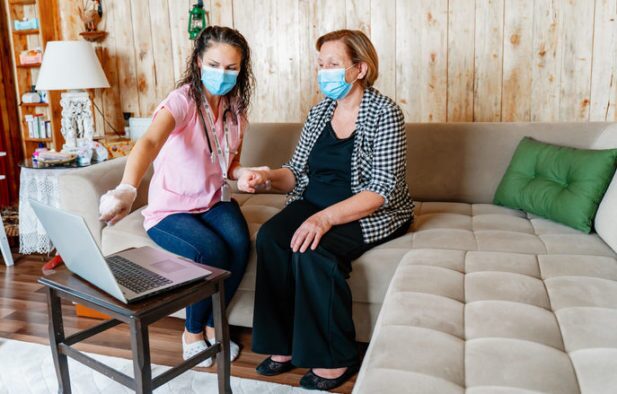Pandemic Perspectives: COVID and Health Care Providers

Courtesy of guest author Lori-Ann St. Louis, (Hon(s)), MSW, RSW
Director of Social Work at Abilities Rehabilitation Services
In March of 2019, had you told me that in a year from now, society is locked down, lineups are the standard at grocery stores, the borders are closed, masks are worn by everyone and you cannot see your primary health care provider, I would have likely completed a thorough mental health assessment on you. The reality of what we are living in today is so far removed from the norms that we established in the past. As regulated health care professionals, we had to quickly adapt to these changing times in order to meet the varied needs of the individuals we serve. The need to re-write the rules of engagement was an essential necessity as we could not simply remain in a holding pattern and wait for the pandemic to pass, as the individuals we support did not spontaneously recover. In fact, the opposite held true, in that many of the individuals we treat deteriorated physically and emotionally.
The beginning of the pandemic restrictions resulted in our teams of regulated health professionals working closely and tirelessly with their regulatory bodies in order to establish new protocols and to provide insights as to how these changes affected the services we offer. Some of the changes were supportive while others were quite restrictive with the end goal of protecting the regulated health professionals and the individuals with whom we work. For example, regulatory colleges for occupational therapy, physiotherapy, social work, and psychology all developed directives with respect to in person and essential interventions. As practitioners we had to quickly adapt to these changing times and interpret how these directives impacted on service provision. These included such tasks as researching secure virtual treatment platforms, and adapting our consent forms. I recall when we were able to resume essential services in person, and the challenge became procuring personal protective equipment. It was helpful that Abilities Rehabilitation and Counselling Services provided support in remote and underserviced areas over the past 20 years and had already understood the challenges that come with remote service delivery. This was instrumental as many of the systems had already been established and we were able to ensure a continuity of care for the individuals we treat.
During the initial stages of the pandemic, I observed the physical and emotional well-being of the individuals with whom I work deteriorate without active treatment and these same individuals had to adjust to a ‘new normal’ without the normal supports afforded to them. For example, regulatory restrictions enacted resulted in physiotherapists not being able to carry out in person sessions (unless essentially required) resulting in physical therapy initially being stopped or carried out remotely. At the same time, I witnessed the resiliency and the ability of therapists to adapt to these complex changes. Not only did we have to modify how we deliver service, we also had to change the focus of our treatment. Coping with Isolation and monitoring well-being became standard discussions during treatment. The importance of connecting with others, maintaining a self-care practice, and developing structure and routine when you are confined to your home were at the forefront. Additionally, the need for therapists to collaborate with other medical professionals was instrumental to ensure that our client’s were being supported during this time. I was comforted by the level of accommodation I witnessed with my client’s primary medical providers. I received calls directly from family doctors and psychiatrists in order to assist with planning and managing their patient’s primary health care.
Now fast forward to six months after the initial restrictions were enacted. We live in a ‘new normal’. Individuals are receptive and regularly complete the COVID-19 Health Questionnaires prior to treatment. Physical distancing as well as the donning of protective equipment are the standard. We recognize that as we move forward that we may have to take steps back and modify again how we support clients.
I am comforted that during these unique and unprecedented times, the professionals have continued to be strong advocates to ensure continuity of treatment for our clients. What I have learned is that as a community of rehabilitation professionals we have worked collaboratively at the local and provincial level to ensure that we maintain best practices and ensure the safety of the public. As regulated health professionals who primarily work directly with clients in the community, we have adapted, in order to maintain service to our clients. It has been a rewarding experience to be part of this community and walk this stressful path with our clients during this unique and challenging time.
[This article originally appeared in Oatley Vigmond’s Fall 2020 newsletter, The Law and You for Healthcare Professionals. Please e-mail events@oatleyvigmond.com to opt-in to receive it.]
